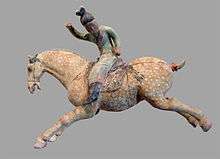Jimi system
The Jimi system (Chinese: 羁縻制) or Jimifuzhou (羁縻府州) was a self-rule administrative and political organization system used in China between the 7th century and 10th century. It originated in the Tang dynasty, by the 650s it had reached to its peak and began to decline by the 740s.[1] It was subsequently used in the Song, Mongol Yuan, Ming and Qing dynasties, known as the Tusi system (土司制) until around 1726, when a new civil order under the Qing government was established.[2] It should not to be confused with the tributary system.[3] The term Jimi was first seen in the annotation of Shiji quoted by Sima Zhen from a book of Eastern Han era, which implied to a man directing a horse or ox by the use of rein.[4]
Characteristics
The system was a model of Chinese administrative units established for foreign rulers or chiefs that were either militarily subdued or self-subdued and naturalized. They received their duty from central authority while keeping their original status, and passed on their duty to heirs.[5] They were to provide annual tribute, following the foreign policy and superintend by the central authority.[2] In terms of foreign policy, they would collaborate with the officials sent by the central authority in administration, participate in military affairs of central authority's interest, and obey the assignation made by the central authority.[6] The system was first introduced by commander Li Daliang between August 23 and September 25, 630.[7]
It mainly consisted of three levels: the command area (都督府), prefecture (州) and county (县). Known collectively as Jimifuzhou or the loose-control administrative units, they were not commonly confused with Zhengzhou (正州) or the regular administrative units.[8] In additions, there were also two short-lived loose-control protectorates (duhufu 都护府) established in the former Western Turkic Khaganate at around the Tarbagatai Mountains and Lake Balkhash in 658, the only loose-control protectorates ever established.[9][10] In some cases, a moderate number of loose-control counties were also established under the jurisdiction of a regular prefecture at the border of Tang proper.[8] The loose-control administrative units, specifically the command area and prefecture, were established shortly after a region, state or tribe was subdued and formed as a political division within the extent of a separated regular protectorate.[11]
They were established in the area of today's northern Hebei, northern Shaanxi, Gansu, Ningxia, Inner Mongolia, Outer Mongolia, Siberia, Sogdiana and Afghanistan to the north and west, Hunan and Guangxi to the south, western Sichuan, Guizhou and Yunnan to the southwest, where they co-existed with the regular prefecture, and also parts of Inner and Central Asia during the early Tang empire.[12] Until 755, there were approximately 1,000 or around 856 loose-control prefectures established within the former khaganate and state, about 2.6 times the regular prefecture.[2][13]
Notes
References
- Zhou, Weiyan, "Jimizhou". Encyclopedia of China, 1st ed.
- Yuan, Bolan, Min, Shenglan and Huang, Li. "Tang Song Minzu Zhengce Jimi Wenti Zhi Bijiao Yanjiu" ("Ethnic Policy of the Tang and Song Dynasties, A Comparative Study on the Question of Jimi"). Journal of Northwest University for Nationalities. 2004.5. ISSN 1001-5140.
- Liu, Tong (1998). The Study of Tang Dynasty's Jimifuzhou. Xi'an: Northwest University Press. ISBN 7-5604-1298-X.
- Tian, Suisheng et al. (1994). A Comprehensive Knowledge of Local Government. Beijing: China's Archives Press. ISBN 7-80019-461-2.
- Zhang, Youjun et al. (1992). General Discussion of Ethnic Policy in China. Nanming: Guangxi Education Press. ISBN 7-5435-1527-X.
